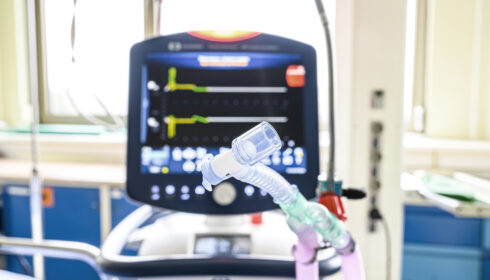Determann
Ventilation with lower tidal volumes as compared with conventional tidal volumes for patients without acute lung injury
Determann et al. Critical Care 2010; 14:R1.
Clinical Question
- In mechanically ventilated patients without acute lung injury or acute respiratory distress (ALI/ARDS), does lower tidal volume ventilation at 6 ml/kg (Vt-low), compared to conventional tidal volume ventilation at 10 ml/kg (Vt-high), reduce cytokine levels associated with lung injury?
Design
- Randomised, controlled trial
- Unblinded (clinicians and researchers aware of allocation)
- Sealed, opaque envelopes concealed group allocation
- Block randomisation in sizes of 50 stratified by research site
- Intention-to-treat statistical analysis
- Interim safety analysis of secondary outcome data, by blinded independent clinicians
- Power calculation based upon data from similar trial in patients with ALI/ARDS
- Expected baseline IL-6 level of 250 pg/ml
- Powered to detect difference of 100 pg/ml at 80%
- Two-sided significance level of 0.05
- 49 patients required, but quadrupled to target of 200 after best guess difference between “with ALI/ARDS” and “without ALI/ARDS” populations
Setting
- Two Dutch mixed medical / surgical ICUs (one ‘academic’ and one ‘regional teaching hospital’)
- January 2005 to December 2007 (prior to Berlin definition of ARDS)
Population
- Inclusion: no diagnosis of ALI / ARDS; anticipated need for mechanical ventilation of more than 72 hours.
- Exclusion: under 18 years of age; pregnancy; uncontrolled raised intracranial pressure; COPD or restrictive lung disease; on immunosuppressive drugs (up to 100mg hydrocortisone equivalent was allowed); pulmonary embolism; previous operative lung volume reduction.
- 347 eligible patients, 195 (56% excluded, of which: 48% met criterial, 48 refused consent, 4% clinician’s discretion), 152 randomised and 150 included in analysis.
- Intervention group were younger and more commonly smokers. Other demographics were comparably similar:
- Age: Vt-low 63 (SD ±15) vs Vt-high 58 (SD ±17); p=0.06
- Smoker: Vt-low 76% vs Vt-high 61%; p=0.04
- In both groups, around half of patients included were admitted because of ‘cardiac arrest’ or ‘neurologic disease’
Intervention
- Vt-low: Volume-controlled ventilation (VCV) at 6 ml/kg predicted body weight
- Allowed to increase to 7 or 8 ml/kg if severe dyspnoea
- Achieved 6.4 ml/kg (SD ±1.0)
- Mean Pmax 21.6 cmH2O (SD ±7.0)
Control
- Vt-high: Volume-controlled ventilation at 10 ml/kg predicted body weight
- Achieved 10.0 ml/kg (SD ±1.0)
- Mean Pmax 24.6 cm H2O (SD ±6.7)
Common management of both groups
- Trial of pressure-supported ventilation (PSV) three times daily
- Continued on PSV if tolerated, at discretion of attending clinician
- Pressure adjusted to meet allocated target tidal volume
- If attending clinician preferred PSV over VCV, above target tidal volumes were allowed, but patient remained in allocated group for statistical analysis
- PEEP and FiO2 were adjusted according to local protocol (not provided)
- Weaning from ventilator occurred when standard parameters were met
- Extubation was at the attending clinician’s discretion
- If re-intubated within 28-days, patient continued in trial in allocated group
- If ALI/ARDS was diagnosed, ventilation reduced to 6 ml/kg for control group in keeping with best evidence practice
- Alternate day bronchoscopy performed for lavage and analysis of cytokines, paired with serum analysis
Outcome
- Primary outcome:
- Bronchial lavage cytokines: baseline TNF-α, IL-1β and IL-6 were comparably similar and did not become significantly different between the two groups
- Exact number not provided. Graphically represented in paper.
- Plasma cytokines: baseline IL-6 were comparably similar, both groups decreased over time, and the Vt-low group fell statistically significantly lower
- Baseline: Vt-low 51 ng/ml vs Vt-high 50 ng/ml; p=0.74
- Day-4: Vt-low 11 ng/ml vs Vt-high 21 ng/ml; p=0.01
- Bronchial lavage cytokines: baseline TNF-α, IL-1β and IL-6 were comparably similar and did not become significantly different between the two groups
- Secondary outcome:
- Development of lung injury
- Trial was halted at interim analysis due to statistically significant difference in ALI/ARDS incidence
- Vt-low n=2 (2.6%) vs Vt-high n=10 (13.5%); p=0.01
- Odds ratio for developing ALI/ARDS is 5.1 for Vt-high compared with Vt-low
- Tertiary data:
- Day-7 ventilation of survivors: Vt-low n=9 (17%) vs Vt-high n=13 (25%); p=0.31
- Median 28-day ventilator-free-days: Vt-low 24 days vs Vt-high 28 days; p=0.88
- 28-day mortality: Vt-low n=24 (32%) vs Vt-high n=23 (31%); p=0.94
Authors’ Conclusions
- The data suggests that mechanical ventilation with tidal volumes of 10 ml/kg is associated with sustained plasma cytokine release and contributes to development of acute lung injury and acute respiratory distress syndrome
Strengths
- Given that many institutions have adopted Vt-low as a normal preventative ventilation strategy, (based on ARDSnet study and non-ARDS observational data) it is important that this clinical question is asked. This RCT is a good attempt to find supportive / refuting data.
- Attempt to overcome unblinded methodology by objective biochemical primary outcome
- Secondary outcome analysis by blinded clinicians
- Strict intention-to-treat analysis
Weaknesses
- Definition of ALI/ARDS in this trial pre-dates Berlin criteria that are used now
- Powered for non-clinically meaningful outcome
- Lack of blinding and significant “clinician’s discretion” management may have introduced bias but it is unclear the bias effect size and predominant direction of this
- Interim safety analysis of the secondary outcome was not initially planned and was therefore not statistically anticipated in power calculation. It was insisted upon by one of the institution’s clinicians, as they suspected a significant difference between the groups. Early stopping tends to exaggerate effect, and may have led to an early false conclusion. The authors suggest that given the secondary outcome significance was p=0.01, this is unlikely (i.e. it was strongly significant difference). This is a significant weakness of the study, and some commentators have suggested it was not necessary (see links below).
- Only recruited in two Dutch ICUs with local (and unavailable) protocols
- Over 3 years, these two ICUs only identified 347 eligible patients (adults with >3 days mechanical ventilation). This appears lower than expected. No details on screening criteria (consecutive, in-hours only, etc?). How many patients weren’t included that could have been? Selection bias may have been present, but the data are not presented to be certain.
The Bottom Line
- This intriguing and important clinical question is not sufficiently answered by this study, but it provides a suggestion that preventative lower tidal volume ventilation is best clinical practice.
- Further larger trials are required if clinicians feel equipoise still exists.
External Links
- [article] Ventilation with lower tidal volumes as compared with conventional tidal volumes for patients without acute lung injury: a preventive randomized controlled trial by Determine et al
- [commentary] Is acute respiratory distress syndrome an iatrogenic disease? by Villar and Slutsky
- [review] Protective mechanical ventilation in the non-injured lung: review and meta-analysis by Sutherasan et al
Metadata
Summary author: @DuncanChambler
Summary date: 6th March 2015
Peer-review editor: @stevemathieu75



